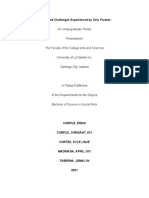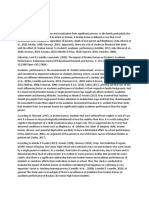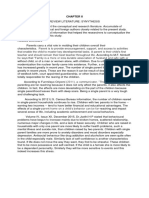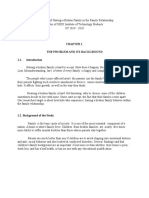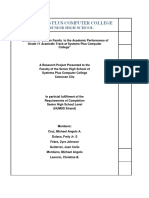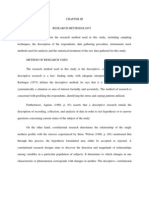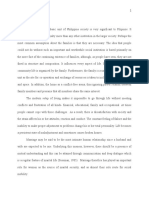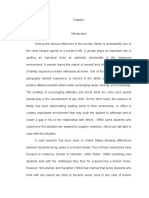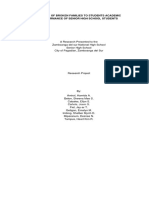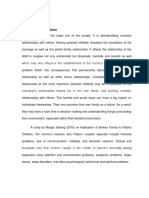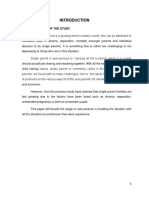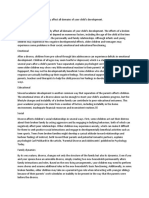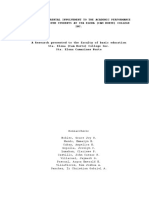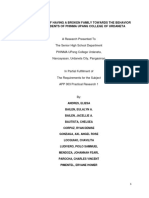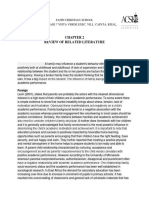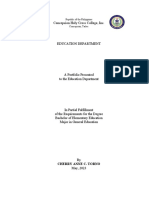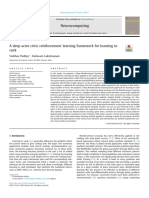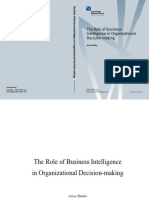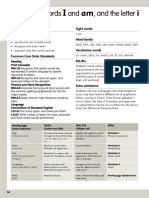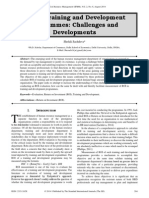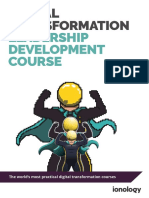Literature Review
Literature Review
Uploaded by
api-254434293Copyright:
Available Formats
Literature Review
Literature Review
Uploaded by
api-254434293Original Title
Copyright
Available Formats
Share this document
Did you find this document useful?
Is this content inappropriate?
Copyright:
Available Formats
Literature Review
Literature Review
Uploaded by
api-254434293Copyright:
Available Formats
The Hardships of Single Parents
Sarah Villa
Literature Review
ENGL 1311
Sarah Villa
The Hardships of Single Parents
Abstract
Survey data shows that Americans have become more and more accepting of single-parent families
formed through divorce and non-marital childbearing since 1960. But knowledge of attitudes about
single-parent families is limited in terms of both time period and detail. Single-parent families can no
longer be viewed as nontraditional families. These families are all around us today. The U.S. Census
Bureau reported that about 30 percent of American families are led by only one parent. Single-parent
households totaled over 12 million in the year of 2000. As more single-parent families have appeared on
the American landscape, interest has grown as to what is the effect of these households on our
children's wellbeing. Over the past four decades, the patterns of family structure have changed intensely
in the United States. An increase in the numbers and proportion of children born outside of marriage
and a rise in divorce rates have contributed to an increase in the proportions of children growing up in
single-parent families since 1960. These changes have created considerably public concern and
controversy, particularly about the effects of these changes on the well-being of children. Over the past
20 years, a body of research has developed on how changes in patterns of family structure affect
children. Most researchers now agree that together these studies support the notion that, on average,
children do best when raised by their two married, biological parents who have low-conflict
relationships.
Introduction
Single parents are effectively left with the task of sole parenting and all related roles and
responsibilities of raising children. Single parents are lone caretakers and sole supporters of the family. A
single parent has to cope with all the care giving, nurturing, role modeling, challenges, rewards,
Sarah Villa
The Hardships of Single Parents
obstacles and joys meant for a partnership of two. Being a single parent can be overwhelming and it is
extremely tough to be a single parent having no one to share the load of responsibility.
Personal circumstances, divorce, abandonment, and death of partner are some of the main reasons that
leave the main custodial responsibilities of raising children to a single parent. Few parents are really
prepared for dealing with the aftermath of the loss of a partner regardless of the cause. Feelings of
desperation, being overwhelmed and stressed out are very typical.
The positive negative effects single parenting and the single parenting demands can seem like
insurmountable challenges on any given day. Here are a few guides single parenting to help you make
the transition into single parenting and to help you face the challenges single parenting brings.
1. What are some of the impacts for children in a single-parent home, what are the impacts for
the parent?
Researchers have several theories to explain why children growing up with single parents have a
noteworthy high risk of experiencing cognitive, social, and emotional problems. Most refer either to the
economic and parental resources available to children or to the stressful events and circumstances to
which these children must adapt.
For a variety of reasons documented elsewhere in this volume, most children living with single parents
are economically disadvantaged. It is difficult for poor single parents to afford the books, home
computers, and private lessons that make it easier for their children to succeed in school. Similarly, they
cannot afford clothes, shoes, cell phones, and other consumer goods that give their children status
among their peers. Moreover, many live in rundown neighborhoods with high crime rates, low-quality
schools, and few community services. Consistent with these observations, many studies have shown
that economic resources explain some of the differences in well-being between children with single
Sarah Villa
The Hardships of Single Parents
parents and those with continuously married parent. Interviews with children reveal that losing contact
with fathers is one of the most painful outcomes of divorce.
Children also thrive when their parents have a cooperative co-parental relationship. When parents
agree on the rules and support one another's decisions, children learn that parental authority is not
arbitrary. Parental agreement also means that children are not subjected to inconsistent discipline when
they misbehave. Consistency between parents helps children to learn and internalize social norms and
moral values. Another benefit of a positive co-parental relationship is the modeling of interpersonal
skills, such as showing respect, communicating clearly, and resolving disputes through negotiation and
compromise. Children who learn these skills by observing their parents have positive relationships with
peers and, later, with intimate partners. When children's parents live in separate households, however,
cooperative co-parenting is not the norm. Although some parents remain locked in conflict for many
years, especially if a divorce is involved, most gradually disengage and communicate little with one
another. At best, most children living with single parents experience parallel parenting rather than
cooperative co-parenting.
Children living with single parents are exposed to more stressful experiences and circumstances than are
children living with continuously married parents. Although scholars define stress in somewhat different
ways, most assume that it occurs when external demands exceed people's coping resources. This results
in feelings of emotional distress, a reduced capacity to function in school, work, and family roles, and an
increase in physiological indicators of arousal. Economic hardship, inept parenting, and loss of contact
with a parent (as noted earlier) can be stressful for children. Observing conflict and hostility between
resident and nonresident parents also is stressful. Conflict between nonresident parents appears to be
particularly harmful when children feel that they are caught in the middle, as when one parent
denigrates the other parent in front of the child, when children are asked to transmit critical or
Sarah Villa
The Hardships of Single Parents
emotionally negative messages from one parent to the other, and when one parent attempts to recruit
the child as an ally against the other.54 Interparental conflict is a direct stressor for children, and it can
also interfere with their attachments to parents, resulting in feelings of emotional insecurity.
Moving is a difficult experience for many children, especially when it involves losing contact with
neighborhood friends. Moreover, moves that require changing schools can put children out of step with
their classmates in terms of the curriculum. Children with single parents move more frequently than
other children do, partly because of economic hardship (which forces parents to seek less expensive
accommodation in other areas) and partly because single parents form new romantic attachments (as
when a single mother marries and moves in with her new husband). Studies show that frequent moving
increases the risk of academic, behavioral, and emotional problems for children with single parents. For
many children, as noted, the addition of a stepparent to the household is a stressful change. And when
remarriages end in divorce, children are exposed to yet more stressful transitions. Indeed, some studies
indicate that the number of transitions that children experience while growing up (including multiple
parental divorces, cohabitations, and remarriages) is a good predictor of their behavioral and emotional
problems as adolescents and young adults.
2. What are some of the difficulties single parent homes face, are there benefits to having a
single parent home?
As mentioned before, single-parent families are very common in today's world. A single parent is a
parent with one or more children, who is not living with any of the children's other parents. The
percentage of children who live with two parents has been declining among all racial and ethnic
groups throughout the years. There are many statistics out there regarding this fast growing family
phenomenon. In the United States, 22 million children go home to one parent, and 83 percent of
those parents are moms. A single-mother home is much more common than a single-father home,
Sarah Villa
The Hardships of Single Parents
however the amount of single fathers has grown by 60% in the last ten years alone. It has been
found that of all custodial parents, 85% were mothers and 15% were fathers. Also, half of all
children involved in one-parent households headed by the mother do not see their fathers on a
regular basis two years after the breakup of the family. Of children living with one parent: 38% lived
with a divorced parent; 35% with a never-married parent; 19% with a separated parent; 4% with a
widowed parent; and 4% with a parent whose spouse lived elsewhere because of business or some
other reason. A great deal is known about what a single-parent household is, as well as how the
single-parent household has evolved and developed throughout the years. It is because of this
knowledge that the effects of this type of household on children has been spotlighted and studied
greatly.
It has been found through varied research that children in single-parent homes generally fare worse
than those homes with two parents. Statistically, in the United States, family structure does
contribute to certain characteristics of a child's well-being. For example, there is a prevalence of
lower birthrates and higher death rates among infants when there is just one parent. Also, the
number of children ages 15-17 in school and in good health is much lower in this group of children,
and the number of children becoming pregnant at these ages is increasing. There are also signs that
children who have gone through a divorce may have problems with depression, emotional stress,
and difficulties in school. It has been found that adolescents from single-parent families were found
to be three times more likely to be depressed than those living with two parents. Single parent
homes are also associated with criminal activity in the U.S.A. Children from a single-parent
household account for 72% of teenage murderers, 60% percent of people who commit rape crimes
and are eleven times more likely to exhibit violent behavior. These statistics are astounding and the
problems that accompany single-parenthood appear volatile.
Sarah Villa
The Hardships of Single Parents
Problems found in the single-parent household may not be because of the parent who raised these
children, but can be linked to other things that are also related to single parenting. It has been
pointed out that when there is only one parent, the family is often less well off financially and this is
the main reason for so many family problems. Reports show that the effects of coming from a low-
income family can include things like lower education levels, lower economic achievement and can
result in leaving the child feeling isolated and lonely. Being a single parent and struggling for money
often coincide. It is also true that children of one-parent households are generally less supervised,
their actions are less monitored and there is usually less communication between the child and
parent. It would appear that being a part of a single-parent household indicates a negative family
environment. It should be said however that many single-parent families find a balance and
successfully thrive in today's world.
3. Are there other forms of parenting outside of single parent homes, and two-parented homes?
The answers to these questions tend to reflect different and diverse patterns, often based upon
the level of income in the countries. For example, children living with two parents tend to
experience better educational outcomes compared with those living with one or no parents in
high- and middle-income countries, although there are a number of exceptions to this finding.
The experiences of children in low-income countries appear to be much more diverse. In
particular, in these countries, living with one parent isnt necessarily a negative experience, and
appears to be associated with benefits for some children when it comes to education. However,
children who dont live with either parent tend to have the worst educational outcomes (based
on the measures examined here) in all regions of the world. The results presented in this essay
provide a more comprehensive and global look at the link between family structure and
childrens education than has been done in the past, although additional work is needed to
Sarah Villa
The Hardships of Single Parents
continue to understand how and why families matter for childrens education and other aspects
of child well-being.
4. Which type of parenting do you think would be best for children?
Research has found that the best adjusted children, particularly in terms of social competence, have
parents with an authoritative, moderate parenting style. These parents are able to balance clearly
stated, high demands with emotional responsiveness and respect for their child's autonomy. Both
authoritative parents have high expectations of their children and use control, but the overly strict
parent expects the child to unquestioningly accept parental judgments and allows the child little
freedom of expression. Children of overly strict parents are apt to be reliant on the voice of authority
and to be lacking in spontaneity. In contrast, the authoritative parent permits the child enough freedom
of expression so that he or she can develop a sense of independence. Permissive parents make few
demands and their children have been found to have difficulty controlling their impulses, and can be
immature and reluctant to accept responsibility.
One example of the effect of parenting style on the development of children was published in the June
2006 issue of Pediatrics. A research team headed by Dr. Kyung E. Rhee, a pediatrician at Boston Medical
Center, analyzed data for 872 children collected by the National Institute of Child Health and Human
Development. They assessed the relationship between child-rearing style, assessed when the children
were 4 and a half years of age, and their weight status two years later.
By that time more than 11 percent of the children were overweight and an additional 13.4 percent were
considered at risk. The children of authoritarian mothers were nearly five times as likely to be
Sarah Villa
The Hardships of Single Parents
overweight as those of authoritative mothers, and children of permissive or uninvolved parents were at
more than three times the risk. The researchers stated that an overly strict upbringing can have a
negative impact on weight because the children may fail to learn to eat on the basis of hunger and
satiety. In such families parents may use food as a reward, insist that children clean their plates, or
restrict the kind or amount of food a child can eat
Conclusion
An important conclusion is that while the incidence of single-parent families and non-
employment by parents contributes to high poverty rates for many children, this pattern does not hold
for families who have higher rates of employment and higher incidences of intact two-parent families,
yet remain in poverty. Policies for low-income families, such as those in national welfare reforms that
emphasize employment and stable marriage as primary routes out of poverty.
Sarah Villa
The Hardships of Single Parents
Sources
"Facts About Single Parent Families." Parents Without Partners. Parent Without Partners. 13 Mar. 2006 .
Garis, Dalton. "Poverty, Single-Parent Households, and Youth At-Risk Behavior: An Empirical Study."
Journal of Economic Issues 1998: 1079-1085.
Hetherington, E. Mavis. Coping with Divorce, Single Parenting, and Remarriage: A Risk and Resiliency
Perspective. Mahwah: Lawrence Erlbaum Associates Inc., 1999.
Lamb, Michael E. Parenting and Child Development in "Nontraditional" Families. Mahwah: Lawrence
Erlbaum Associates, 1998.
Thornton 1989; Thornton and Young-DeMarco 2001; Pagnini and Rindfuss 1993
You might also like
- Unit 7 - 8 - 9Document11 pagesUnit 7 - 8 - 9Samantha Jiménez Suárez100% (1)
- Practical ResearchDocument9 pagesPractical ResearchBestFriend Goal100% (1)
- Divorce Concept PaperDocument14 pagesDivorce Concept PaperClaire Greenlee100% (1)
- Chapter IiDocument9 pagesChapter IiKimberly LactaotaoNo ratings yet
- Single Parent StudyDocument27 pagesSingle Parent StudyJohn Carl Aparicio83% (6)
- Chapter 2Document32 pagesChapter 2princess anneNo ratings yet
- Hardship of Single ParentsDocument10 pagesHardship of Single ParentsSpartanNo ratings yet
- Impacts of Single Parenting On Child Development (Final)Document35 pagesImpacts of Single Parenting On Child Development (Final)Jalre Alido0% (1)
- Statement of ProblemDocument8 pagesStatement of Problemanadiadavid50% (2)
- Issues and Challenges Experienced by Solo Parent1Document43 pagesIssues and Challenges Experienced by Solo Parent1April Joy Andres MadriagaNo ratings yet
- Chapter 2-1Document22 pagesChapter 2-1Aqui De LeonNo ratings yet
- Review of Related Literature and StudiesDocument9 pagesReview of Related Literature and StudiesMaria Theresa Turingan100% (1)
- RRL & RRS (Family Problem)Document3 pagesRRL & RRS (Family Problem)Manic James CarloNo ratings yet
- Sarah's Group PresentationDocument27 pagesSarah's Group PresentationMary Jean PalconNo ratings yet
- Revised Chapter 1Document17 pagesRevised Chapter 1Manuel Oliva100% (1)
- CHAPTER II PracticalDocument3 pagesCHAPTER II Practicalmaria mariaNo ratings yet
- RESEARCHDocument31 pagesRESEARCHPaopao MacalaladNo ratings yet
- Research Chapter 1 and 2 FINALDocument22 pagesResearch Chapter 1 and 2 FINALNorol-in Sabacan0% (1)
- Chapter 1Document5 pagesChapter 1polianNo ratings yet
- Analysis of The Effects of Broken Family On Ourl Lady of Fatima UniversityDocument10 pagesAnalysis of The Effects of Broken Family On Ourl Lady of Fatima UniversityMark Angelo MacedaNo ratings yet
- The Problem and Its Background 1.1Document6 pagesThe Problem and Its Background 1.1Arjay Rosero100% (1)
- Ef78 PDFDocument68 pagesEf78 PDFIzzy Pastrana Del Valle100% (1)
- Difference of Broken Family To The Academic PerformanceDocument8 pagesDifference of Broken Family To The Academic PerformanceJoselito Leoncio Jr.No ratings yet
- The Relationship Between Family Background and Academic Performance of Secondary School StudentsDocument57 pagesThe Relationship Between Family Background and Academic Performance of Secondary School StudentsMAKE MUSOLININo ratings yet
- Chapter IIIDocument5 pagesChapter IIIJohn Mark Marquez100% (4)
- Introduction Broken HomesDocument2 pagesIntroduction Broken HomesNslaimoa Ajh100% (6)
- Papel NG Magdedefense at PapasaDocument16 pagesPapel NG Magdedefense at Papasa메리 위33% (3)
- Practical Research 2Document7 pagesPractical Research 2Jesa mae TorinoNo ratings yet
- Broken FamilyDocument15 pagesBroken FamilyGabriel VillaveraNo ratings yet
- Thesis Single Parent As A NonDocument76 pagesThesis Single Parent As A NonValli Faith Estacion Bibit71% (7)
- Lived Experiences of Generation Z Solo Parent Mothers 1Document20 pagesLived Experiences of Generation Z Solo Parent Mothers 1Minette Fritzie MarcosNo ratings yet
- INTRODUCTION Broken FamDocument3 pagesINTRODUCTION Broken FamJimie YacubNo ratings yet
- All in One For FINALDocument107 pagesAll in One For FINALAshirt ValdescoNo ratings yet
- II. Review of Related Literature and StudiesDocument11 pagesII. Review of Related Literature and StudiesMa.socorro Saballa75% (4)
- Review of A Related Literature and StudiesDocument6 pagesReview of A Related Literature and StudiesJohnreal PangilinanNo ratings yet
- Broken Family: It's Implication To Senior High School Student's Academic Performance at Siocon National High SchoolDocument5 pagesBroken Family: It's Implication To Senior High School Student's Academic Performance at Siocon National High School윤송이No ratings yet
- Pinaka Final Nani PistiDocument6 pagesPinaka Final Nani PistiBryan FielNo ratings yet
- The Influence of Parental Separation On Academic Achievement OF Grade 11 Humss B of Cavite West Point CollegeDocument51 pagesThe Influence of Parental Separation On Academic Achievement OF Grade 11 Humss B of Cavite West Point CollegeJo BaronNo ratings yet
- Parental Involvement and Academic Performance Parental InvolvementDocument3 pagesParental Involvement and Academic Performance Parental InvolvementGaBu YT100% (1)
- RESEARCHDocument5 pagesRESEARCHroseve cabalunaNo ratings yet
- A. Background of The StudyDocument9 pagesA. Background of The StudyMac Mac OlarteNo ratings yet
- The Impact of Having Separated Parent To The Performance of The Grade 12 Student of Best College of PolomolokDocument29 pagesThe Impact of Having Separated Parent To The Performance of The Grade 12 Student of Best College of PolomolokJoseph Xyrel MalacadNo ratings yet
- Broken Family EffectsDocument1 pageBroken Family EffectsRaine Dizon100% (1)
- Effects of Parental Involvement To The Academic Performance of Grade 11 Stem Students at Sta ElenaDocument11 pagesEffects of Parental Involvement To The Academic Performance of Grade 11 Stem Students at Sta Elenaisrael hapitaNo ratings yet
- Effects of Broken FamilyDocument92 pagesEffects of Broken FamilyJohannah Fearl Mendoza75% (4)
- Parental Separation and The Academic AchievementDocument15 pagesParental Separation and The Academic AchievementChai Chai100% (3)
- The Relationship Between Parental Involvement and Academic Motivation of Grade 11 and 12 Senior High School StudentsDocument11 pagesThe Relationship Between Parental Involvement and Academic Motivation of Grade 11 and 12 Senior High School StudentsIOER International Multidisciplinary Research Journal ( IIMRJ)No ratings yet
- Socio-Economic Status and Livelihood Prospects of Solo Parents in Catanduanes, PhilippinesDocument9 pagesSocio-Economic Status and Livelihood Prospects of Solo Parents in Catanduanes, PhilippinesHazel ArmeroNo ratings yet
- CHAPTER 2 Update 2Document4 pagesCHAPTER 2 Update 2yana suriaNo ratings yet
- Effects of The Absence of Parents To The Students of Bulacan State University - Sarmiento CampusDocument37 pagesEffects of The Absence of Parents To The Students of Bulacan State University - Sarmiento CampusPerry Arcilla SerapioNo ratings yet
- Research in Daily Life 2Document21 pagesResearch in Daily Life 2Elay RosalesNo ratings yet
- Cara ResearchDocument30 pagesCara ResearchMatt MoralesNo ratings yet
- Chapter 3 AND Chapter 5 Broken FamilyDocument7 pagesChapter 3 AND Chapter 5 Broken FamilyIcy Grace Pacle PacleNo ratings yet
- Parental Expectations Effect of Perceived Academic Stress On Students PerformanceDocument8 pagesParental Expectations Effect of Perceived Academic Stress On Students PerformancePhúc TokyoNo ratings yet
- Scattered Into Smithereens: The Effects of Broken Homes On The Academic Performance of Kapalong National High School StudentsDocument14 pagesScattered Into Smithereens: The Effects of Broken Homes On The Academic Performance of Kapalong National High School StudentsLucille Beatrice Pablo TanNo ratings yet
- Chapter I IVDocument33 pagesChapter I IVKimberly Anne AbletiaNo ratings yet
- A Position Paper On The Legalization of Same Sex Marriage in The PhilippinesDocument2 pagesA Position Paper On The Legalization of Same Sex Marriage in The PhilippinesARLENE GRACE AVENUE100% (1)
- Separation of ParentDocument3 pagesSeparation of ParentCute AkoNo ratings yet
- Single ParentsDocument15 pagesSingle ParentsMoorna ChelaehNo ratings yet
- Psychological Effects of A Single Parent FamilyDocument2 pagesPsychological Effects of A Single Parent FamilyJames Marinduque100% (2)
- Thesis About Single ParentingDocument4 pagesThesis About Single Parentingbk3q07k5100% (3)
- Powerpoint Presentation of ps1 Final GbuDocument9 pagesPowerpoint Presentation of ps1 Final Gbuapi-238896663No ratings yet
- ObservationDocument48 pagesObservationBuchi LauriatNo ratings yet
- What BPM and How Often Should I Practice Slow?Document21 pagesWhat BPM and How Often Should I Practice Slow?Rakhshasa100% (3)
- 상관관계와 산점도에 관한 예비수학교사의 SMK 분석 (문지은, 2018)Document62 pages상관관계와 산점도에 관한 예비수학교사의 SMK 분석 (문지은, 2018)Ито ХиробумиNo ratings yet
- Clinical Evaluation 2Document15 pagesClinical Evaluation 2api-284230744No ratings yet
- Handout (4) Summary The Village of Round and Square Houses Ann GrifalconiDocument1 pageHandout (4) Summary The Village of Round and Square Houses Ann GrifalconiJanice baysaNo ratings yet
- A Deep Actor Critic Reinforcement Learning Framework For Learning To Rank 2023Document11 pagesA Deep Actor Critic Reinforcement Learning Framework For Learning To Rank 2023gsbeniNo ratings yet
- Essay On "ROLE OF TEACHERS IN CHARACTER BUILDING"Document2 pagesEssay On "ROLE OF TEACHERS IN CHARACTER BUILDING"Rahul Garg73% (11)
- Tejaswi Resume PDFDocument2 pagesTejaswi Resume PDFRamakanth KatakamNo ratings yet
- Seminars/Training Attended January - August 2022 Consolidated Level of Seminar/ Training Attended Number of Teachers Attended PercentageDocument4 pagesSeminars/Training Attended January - August 2022 Consolidated Level of Seminar/ Training Attended Number of Teachers Attended PercentageJennifer NocumNo ratings yet
- Algorithm Thesis TopicDocument8 pagesAlgorithm Thesis Topictifqbfgig100% (2)
- DDSDDFDocument316 pagesDDSDDFRam KrishnanNo ratings yet
- Zone 4 November 2024 Final Timetable v1Document13 pagesZone 4 November 2024 Final Timetable v1mkhisalgNo ratings yet
- G1 - G10 E-Class Record For New Normal SY 2020-2021 - BlankDocument17 pagesG1 - G10 E-Class Record For New Normal SY 2020-2021 - BlankFred Ryan Canoy DeañoNo ratings yet
- I Am I: Words And, and The LetterDocument6 pagesI Am I: Words And, and The Letterlorena MaraviNo ratings yet
- Irjet V4i5113 PDFDocument5 pagesIrjet V4i5113 PDFAnonymous plQ7aHUNo ratings yet
- Lesson Plan 8 MediaDocument10 pagesLesson Plan 8 Mediamoscaliuc mirabelaNo ratings yet
- Download ebooks file Pilates 3rd Edition Rael Isacowitz all chaptersDocument50 pagesDownload ebooks file Pilates 3rd Edition Rael Isacowitz all chaptersabetathrenfw100% (5)
- Memorandum of Agreement EceDocument5 pagesMemorandum of Agreement EceJunice GranaNo ratings yet
- Language Skills and Their Relationship To Learning Difficulties in English Language From The Students Point of ViewDocument12 pagesLanguage Skills and Their Relationship To Learning Difficulties in English Language From The Students Point of ViewNikken Diahning AnjarmurtiNo ratings yet
- DrRacket GuideDocument351 pagesDrRacket GuideWhite DragonNo ratings yet
- ASSG - Eng-III - F17BCSE050 - Syed Shahabal ShahDocument11 pagesASSG - Eng-III - F17BCSE050 - Syed Shahabal ShahShahab HamdaniNo ratings yet
- Delong 1981 en Cefalo Pat I ADocument4 pagesDelong 1981 en Cefalo Pat I A__aguNo ratings yet
- Baburao ResumeDocument2 pagesBaburao ResumePonangi Babu RaoNo ratings yet
- LibraryDocument99 pagesLibraryRasu RawatNo ratings yet
- What Does Tentative Thesis Statement MeanDocument7 pagesWhat Does Tentative Thesis Statement MeanProfessionalPaperWritingServiceManchester100% (2)
- ROI of Training and Development Programmes: Challenges and DevelopmentsDocument6 pagesROI of Training and Development Programmes: Challenges and Developmentsthesij100% (1)
- 9-Sinf Ingliz Tili 2024Document3 pages9-Sinf Ingliz Tili 20244maktab1985No ratings yet
- Digital Transformation Course Brochure 1Document13 pagesDigital Transformation Course Brochure 1pavelreyesmercadoNo ratings yet









